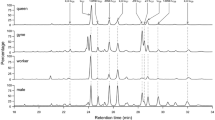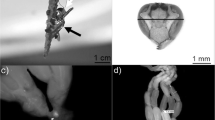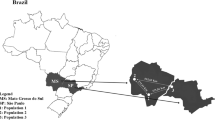Abstract
Cuticular hydrocarbons (CHCs) are information-rich signals in social insects that coordinate behaviors within nests. However, in some taxa, the precise information conveyed by CHCs is poorly understood. In particular, there is a debate over whether CHCs convey information about their bearer's dominance or fertility. Distinguishing between dominance and fertility signaling is difficult because fertility and rank are frequently correlated within social insect colonies. This study disentangles those relationships by examining CHCs of Polistes dominulus paper wasps during the early nest-founding stage before dominance and fertility become correlated. First, we confirm that dominance and fertility are not associated in early spring foundresses. Then we show that CHCs are more strongly associated with fertility than dominance. There was no relationship between cuticular hydrocarbon profiles and a wasp’s ability to dominate rivals through aggression, suggesting that CHCs are unlikely to provide information about dominance. However, there was a significant correlation between ovarian development and the CHC profile, suggesting that CHCs could convey valuable information about their bearer's fertility. Furthermore, our data provide a potential mechanism for chemical signaling of fecundity, as there is a relationship between endogenous juvenile hormone titer (a gonadotropin), degree of ovarian development, and the CHC profile. Hormonal regulation of CHC profile expression offers a physiological mechanism to coordinate behavior, physical state, and signal expression.


Similar content being viewed by others
References
Agrahari M, Gadagkar R (2003) Juvenile hormone accelerates ovarian development and does not affect age polyethism in the primitively eusocial wasp, Ropalidia marginata. J Insect Physiol 49:217–222
Ayasse M, Marlovits T, Tengo J, Taghizadeh T, Francke W (1995) Are there pheromonal dominance signals in the bumblebee Bombus hypnorum (Apidae)? Apidologie 26:163–180
Beekman M (2004) Is her majesty at home? Trends Ecol Evol 19:505
Bloch G, Hefetz A (1999) Regulation of reproduction by dominant workers in bumblebee (Bombus terrestris) queenright colonies. Behav Ecol Sociobiol 45:125–135
Bloch G, Borst DW, Huang Z-Y, Robinson GE, Cnaani J, Hefetz A (2000) Juvenile hormone titres, juvenile hormone biosynthesis, ovarian development and social environment in Bombus terrestris. J Insect Physiol 46:47–57
Bohm MK (1972) Effects of environment and juvenile hormone on ovaries of the wasp, Polistes metricus. J Insect Physiol 18:1875–1883
Bonavita-Cougourdan A, Theraulaz G, Bagneres A-G, Roux M, Pratte M, Provost E, Clement J-L (1991) Cuticular hydrocarbons, social organization and ovarian development in a Polistine wasp: Polistes dominulus Christ. Comp Biochem Physiol 100B:667–680
Brent C, Peeters C, Dietmann V, Crewe R, Vargo E (2005) Hormonal correlates of reproductive status in the queenless ponerine ant, Streblognathus peetersi. J Comp Physiol A Neuroethol Sens Neural Behav Physiol 192:315–320
Butts DP, Camann MA, Espelie KE (1995) Workers and queens of the European hornet Vespa crabro L. have colony-specific cuticular hydrocarbon profiles (Hymenoptera: Vespidae). Insectes Soc 42:45–55
Cuvillier-Hot V, Cobb M, Malosse C, Peeters C (2001) Sex, age, and ovarian activity affect cuticular hydrocarbons in Diacamma ceylonense, a queenless ant. J Insect Physiol 47:485–493
Cuvillier-Hot V, Lenoir A, Crewe R, Malosses C, Peeters C (2004a) Fertility signalling and reproductive skew in queenless ants. Anim Behav 68:1209–1219
Cuvillier-Hot V, Lenoir A, Peeters C (2004b) Reproductive monopoly enforced by sterile police workers in a queenless ant. Behav Ecol 15:970–975
D'Ettorre P, Heinze J, Schulz C, Francke W, Ayasse M (2004) Does she smell like a queen? Chemoreception of a cuticular hydrocarbon signal in the ant Pachycondyla inversa. J Exp Biol 207:1085–1091
Dapporto L, Theodora P, Spacchini C, Pieraccini G, Turillazzi S (2004) Rank and epicuticular hydrocarbons in different populations of the paper wasp Polistes dominulus (Christ) (Hymenoptera, Vespidae). Insect Soc 51:279–286
Dapporto L, Matthew Sledge F, Turillazzi S (2005a) Dynamics of cuticular chemical profiles of Polistes dominulus workers in orphaned nests (Hymenoptera, Vespidae). J Insect Physiol 51:969
Dapporto L, Palagi E, Turillazzi S (2005b) Sociality outside the nest: helpers in pre-hibernating clusters of Polistes dominulus. Ann Zool Fennici 42:135–139
Dapporto L, Palagi E, Cini A, Turillazzi S (2006) Prehibernating aggregations of Polistes dominulus: an occasion to study early dominance in social insects. Naturwissenschaften 93:321–324
Dapporto L, Dani FR, Turillazzi S (2007) Social dominance molds cuticular and egg chemical blends in a paper wasp. Curr Biol 17:R504–R505
de Biseau JC, Passera L, Daloze D, Aron S (2004) Ovarian activity correlates with extreme changes in cuticular hydrocarbon profile in the highly polygynous ant, Linepithema humile. J Insect Physiol 50:585–593
Dietemann V, Peeters C, Liebig J, Thivet V, Hölldobler B (2003) Cuticular hydrocarbons mediate discrimination of reproductives and nonreproductives in the ant Myrmecia gulosa. Proc Natl Acad Sci USA 100:10341–10346
Endler A, Liebig J, Schmitt T, Parker J, Jones GR, Schreier P, Hölldobler B (2004) Surface hydrocarbons of queen eggs regulate worker reproduction in a social insect. Proc Natl Acad Sci USA 101:2945–2950
Gamboa GJ (2004) Kin recognition in eusocial wasps. Ann Zool Fenn 41:789–808
Giray T, Giovanetti M, West-Eberhard MJ (2005) Juvenile hormone, reproduction, and worker behavior in the neotropical social wasp, Polistes canadensis. PNAS 102:3330–3335
Hartfelder K (2000) Insect juvenile hormone: from “status quo” to high society. Braz J Med Biol Res 33:157–177
Heinze J, Stengl B, Sledge MF (2002) Worker rank, reproductive status and cuticular hydrocarbon signature in the ant, Pachydondyla cf. Behav Ecol Sociobiol 52:59–65
Holldobler B (1999) Multimodal signals in ant communication. J Comp Physiol [A] 184:129–141
Hölldobler B, Carlin NF (1987) Anonymity and specificity in the chemical communication signals of social insects. J Comp Physiol [A] 161:567–581
Huang ZY, Robinson GE (1996) Regulation of honey bee division of labor by colony age demography. Behav Ecol & Sociobiol 39:147–158
Huang ZY, Robinson GE, Borst DW (1994) Physiological correlates of division of labor among similarly aged honey bees. J Comp Physiol 74:731–739
Jackson DE (2007) Kin recognition: knowing who's boss in wasp colonies. Curr Biol 17:R547–R549
Jassim O, Huang ZY, Robinson GE (2000) Juvenile hormone profiles of worker honey bees during normal and accelerated behavioral development. J Insect Physiol 46:243–249
Keller L, Nonacs P (1993) The role of queen pheromones in social insects: queen control or queen signal? Anim Behav 45:787–794
Lanzrein B, Gentinetta V, Fehr R, Luscher M (1978) Correlation between haemolymph juvenile hormone titre, corpus allatum volume and corpus allatum in vivo and in vitro activity during oocyte maturation in a cockroach (Nauphoeta cinerea). Gen Comp Endocrinol 36:339–345
Larrere M, Couillaud F (1993) Role of juvenile hormone biosynthesis in dominance status and reproduction of the bumblebee, Bombus terrestris. Behav Ecol Sociobiol 33:335–338
Lengyel F, Westerlund SA, Kaib M (2007) Juvenile hormone III influences task-specific cuticular hydrocarbon profile changes in the ant Myrmicaria eumenoides. J Chem Ecol 33:167–181
Liebig J, Peeters C, Oldham NJ, Markstadter C, Holldobler B (2000) Are variations in cuticular hydrocarbons of queens and workers a reliable signal of fertility in the ant Hapregnathos saltator? PNAS 97:4124–4131
Lorenzi MC, Bagneres AG, Clement JL, Turillazzi S (1997) Polistes biglumis bimaculatus epicuticular hydrocarbons and nestmate recognition (Hymenoptera, Vespidae). Insectes Soc 44:123–138
Maynard Smith J (1982) Evolution and the theory of games. Cambridge University Press, Cambridge
Monnin T, Peeters C (1999) Dominance hierarchy and reproductive conflicts among subordinates in a monogynous queenless ant. Behav Ecol 10:323–332
Monnin T, Malosse C, Peeters C (1998) Solid-phase microextraction and cuticular hydrocarbon differences related to reproductive activity in queenless ant Dinoponera quadriceps. J Chem Ecol 24:473–490
Peeters C, Liebig J (2009) Fertility signaling as a general mechanism of regulating reproductive division of labor in ants. In: Gadau J, Fewell J (eds) Organization of insect societies: from genome to socio-complexity. Harvard University Press, Cambridge, pp 220–242
Peeters C, Monnin T, Malosse C (1999) Cuticular hydrocarbons correlated with reproductive status in a queenless ant. Proc R Soc Lond B 266:1323–1327
Reeve HK (1991) Polistes. In: Ross KG, Matthews RW (eds) The social biology of wasps. Comstock Publishing Associates, Ithaca, pp 99–148
Reeve HK, Nonacs P (1997) Within-group aggression and the value of group members: theory and a field test with social wasps. Behav Ecol 8:75–82
Robinson GE, Vargo EL (1997) Juvenile hormone in adult eusocial hymenoptera: gonadotropin and behavioral pacemaker. Arch Insect Biochem Physiol 35:559–583
Roseler P-F (1991) Reproductive competition during colony establishment. In: Ross KG, Matthews RW (eds) The social biology of wasps. Comstock Publishing Associates, Ithaca, pp 309–335
Roseler PF, Roseler I (1989) Dominance of ovariectomized foundresses of the paper wasp, Polistes gallicus. Insectes Soc 27:97–107
Roseler P-F, Roseler I, Strambi A, Augier R (1984) Influence of insect hormones on the establishment of dominance hierarchies among foundresses of the paper wasp, Polistes gallicus. Behav Ecol Sociobiol 15:133–142
Roseler P-F, Roseler I, Strambi A (1985) Role of ovaries and ecdysteroids in dominance hierarchy establishment among foundresses of the primitively social wasp, Polistes gallicus. Behav Ecol Sociobiol 18:9–13
Sledge MF, Boscaro F, Turillazzi S (2001) Cuticular hydrocarbons and reproductive status in the social wasp Polistes dominulus. Behav Ecol Sociobiol 49:401–409
Sledge MF, Trinca I, Massolo A, Boscaro F, Turillazzi S (2004) Variation in cuticular hydrocarbon signatures, hormonal correlates and establishment of reproductive dominance in a polistine wasp. J Insect Physiol 50:73–83
Smith AA, Holldobler B, Liebig J (2009) Cuticular hydrocarbons reliably identify cheaters and allow enforcement of altruism in a social insect. Curr Biol 19:78–81
Tannure-Nascimento I, Nascimento FS, Zucchi R (2008) The look of royalty: visual and odour signals of reproductive status in a paper wasp. Proc R Soc Lond B Biol Sci 275:2555
Tentschert J, Bestmann HJ, Heinze J (2002) Cuticular compounds of workers and queens in two Leptothorax ant species: a comparison of results obtained by solvent extraction, solid sampling, and SPME. Chemoecology 12:15–21
Tibbetts E, Dale J (2004) A socially enforced signal of quality in a paper wasp. Nature 432:218–222
Tibbetts EA, Izzo AS (2009) Endocrine mediated phenotypic plasticity: condition-dependent effects of juvenile hormone on dominance and fertility of wasp queens. Horm Behav 56:527–31
Tibbetts EA, Lindsay R (2008) Visual signals of status and rival assessment in Polistes dominulus paper wasps. Biol Lett 4:237–239
West-Eberhard MJ (1969) The social biology of polistine wasps. Misc Publ Mus Zool Univ Mich 140:1–101
Acknowledgements
We would like to thank Stefano Turillazzi, as well as the anonymous reviewers for their insightful and helpful comments. We thank David Borst (University of Central Florida) for graciously providing the juvenile hormone antiserum, and also thank James Windak, Megan McGuigan, and Brian Shay for sharing their expertise on use of the GC/MS and help with chemical analysis. Funding to ZYH was provided by MSU Agricultural Experimental Station.
Author information
Authors and Affiliations
Corresponding author
Additional information
Communicated by O. Rueppell
Rights and permissions
About this article
Cite this article
Izzo, A., Wells, M., Huang, Z. et al. Cuticular hydrocarbons correlate with fertility, not dominance, in a paper wasp, Polistes dominulus . Behav Ecol Sociobiol 64, 857–864 (2010). https://doi.org/10.1007/s00265-010-0902-7
Received:
Revised:
Accepted:
Published:
Issue Date:
DOI: https://doi.org/10.1007/s00265-010-0902-7




